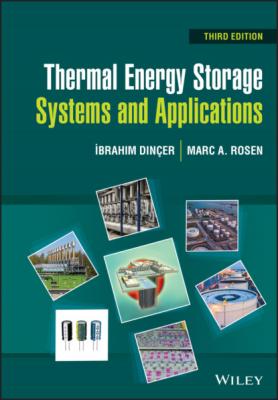Thermal Energy Storage Systems and Applications. Ibrahim Dincer
Читать онлайн.| Название | Thermal Energy Storage Systems and Applications |
|---|---|
| Автор произведения | Ibrahim Dincer |
| Жанр | Физика |
| Серия | |
| Издательство | Физика |
| Год выпуска | 0 |
| isbn | 9781119713142 |
As pointed out by Dincer and Rosen [5, 6], exergy is a measure of the usefulness, quality, or potential of a flow or system to cause change, and is therefore a type of measurement of the potential of a substance to impact the environment.
Exergy analysis is a method that uses the conservation of mass and conservation of energy principles together with the SLT for the design and analysis of systems and processes. The exergy method can be suited for furthering the goal of more efficient energy‐resource use, for it enables the locations, types, and true magnitudes of wastes and losses to be determined. Therefore, exergy analysis can reveal whether or not, and by how much, it is possible to design more efficient energy systems by reducing the sources of inefficiency in existing systems. In the past, exergy was called essergy, availability, and available energy. Table 1.4 lists some relations among essergy, availability, exergy, and free energy.
From the point of view of energy and exergy efficiency, it is important to note that if a fossil fuel‐based energy source is used for a low‐temperature thermal application like space heating or cooling, there would be a great difference between the corresponding energy and exergy efficiencies, perhaps by as much as 50–70% for the energy efficiency and 5% for the exergy efficiency [7]. One may ask why, and to address that question, we provide the following:
Table 1.5 Comparison between energy and exergy.
| Energy | Exergy |
|---|---|
| • Dependent on the parameters of matter or energy flow only, and independent of the environment parameters | • Dependent both on the parameters of matter or energy flow and on the environment parameters |
| • Has values different from zero (which is equal to mc2 in accordance with Einstein's equation) | • Equal to zero (in dead state by virtue of being in equilibrium with the environment) |
| • Guided by the first law of thermodynamics for all processes | • Guided by the first and second laws of thermodynamics for reversible processes only (in irreversible processes, it is destroyed partly or completely) |
| • Limited by the second law of thermodynamics for all processes (including reversible ones) | • Not limited for reversible processes owing to the second law of thermodynamics |
| • Conserved in all processes | • Not conserved in all processes |
High‐quality (e.g. high temperature) energy sources such as fossil fuels are often used for relatively low‐quality (e.g. low‐temperature) processes like water and space heating or cooling.
Exergy efficiency permits a better matching of energy sources and uses, leading to high‐quality energy being reserved for performing high‐quality tasks and not used for low‐quality end uses.
1.5 General Aspects of Fluid Flow
For a good understanding of the operation of TES systems and their components, as well as the behavior of fluid flows, an extensive background on fluid mechanics is essential. In addition to learning the principles of fluid flow, the student and/or engineer should develop an understanding of the properties of fluids and be able to solve practical thermodynamic problems.
In practice, engineers are regularly faced with a large variety of fluid‐flow problems:
subcooled liquids, like water and brine;
mixtures of boiling liquids and the ensuing vapor;
mixtures of refrigerants and absorbents;
mixtures of air and water vapor as humid air; and
low‐ and high‐pressure gases.
To deal effectively with fluid‐flow systems, it is necessary to identify flow categories, defined in predominantly mathematical terms, that allow the appropriate analysis to be undertaken by identifying suitable and acceptable simplifications. Examples of the categories to be introduced include variation of the flow parameters with time (steady or unsteady) or variations along the flow path (uniform or nonuniform). Similarly, compressibility effects may be important in high‐speed gas flows, but may be ignored in many liquid flow situations.
1.5.1 Classification of Fluid Flows
Various criteria allow fluid flows to be classified into the following categories:
uniform or nonuniform,
one‐, two‐, or three‐dimensional,
steady‐ or unsteady‐state,
laminar or turbulent, and
compressible or incompressible.
Also, liquids flowing in open channels may be classified according to their regions, for example, subcritical, critical, or supercritical, and gas flows may be categorized as subsonic, transonic, supersonic, or hypersonic.
(a) Uniform Flow and Nonuniform Flow
If the velocity and cross‐sectional area are constant in the direction of flow, the flow is uniform. Otherwise, the flow is nonuniform.
(b) One‐, Two‐, and Three‐Dimensional Flow
The flow of real fluids occurs in three dimensions. However, in the analysis, the conditions are often simplified to either one‐ or two‐dimensional, depending on the flow problem under consideration. If all fluid and flow parameters (velocity, pressure, elevation, temperature, density, viscosity, etc.) are considered to be uniform throughout any cross‐section and vary only along the direction of flow (Figure 1.6a), the flow is one‐dimensional. Two‐dimensional flow occurs when the fluid and flow parameters have spatial gradients in two directions, that is, x and y axes (Figure 1.6b). In three‐dimensional flow, the fluid and flow parameters vary in three directions, that is, x, y, and z axes, and the gradients of the parameters occur in all three directions.
Figure 1.6 Velocity profiles for flows: (a) one‐dimensional flow, (b) two‐dimensional flow.
(c) Steady Flow
Steady flow is defined as a flow in which the flow conditions do not change with time. However, we may have a steady flow in which the velocity, pressure, and cross‐section of the flow vary from point to point but do not change with time. This
